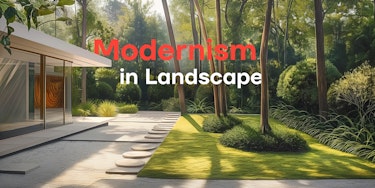Modernism, which emerged in the early 20th century, was a radical departure from the ornate and decorative styles of the past, introducing a new design philosophy that emphasized simplicity, functionality, and a closer relationship with nature. The modernist movement profoundly transformed landscape architecture by promoting clean lines, geometric shapes, and the thoughtful integration of built and natural environments. Rather than creating landscapes that were merely decorative, modernists focused on spaces that enhanced human interaction with nature, promoting practicality and a deeper sense of connection to the environment.
Pioneers like Ludwig Mies van der Rohe, Le Corbusier, and Roberto Burle Marx played pivotal roles in shaping this design ethos. Their work redefined the principles of landscape architecture, pushing boundaries with innovative ideas that blended structural elements with natural landscapes. Today, these ideas continue to influence contemporary design trends, inspiring architects and landscape designers to create spaces that are not only aesthetically pleasing but also sustainable and purposeful.
In this article, we will delve into the key applications of modernist principles in landscape architecture, exploring how they have evolved over time and continue to shape contemporary designs. The main part will highlight the movement's influence on functionalism, the integration of nature and architecture, minimalism, innovative material use, and sustainability. In addition, we will discuss how these principles have inspired new developments, including urban planning, ecological design, and technology integration in modern landscapes.
1. Functionalism in Landscape Design
Functionalism is a defining aspect of modernist landscape architecture, rooted in the belief that every design element should have a specific purpose. This approach goes beyond mere aesthetics, emphasizing practicality and the creation of spaces that serve the needs of their users effectively.
Public and Urban Spaces
In urban areas, modernist principles have led to the design of multifunctional public spaces that accommodate diverse activities. For example, the iconic Millennium Park in Chicago is a modern interpretation of functional landscape design. It features open spaces for gatherings, performance areas, walking paths, and art installations that all serve to engage the community. This type of design has influenced the development of urban parks worldwide, transforming them into vibrant social hubs that cater to a wide range of public activities.
Adaptive Reuse
Functionalism also plays a crucial role in the adaptive reuse of existing structures and landscapes. By repurposing old industrial sites into public parks or recreational areas, designers breathe new life into these spaces while maintaining their historical context. The Landschaftspark Duisburg-Nord in Germany is a notable example, where an old steel factory was transformed into a public park that includes climbing walls, diving pools, and garden spaces. This project illustrates how modernist functionalism can be applied to adapt and repurpose landscapes in ways that are both innovative and respectful of their past.
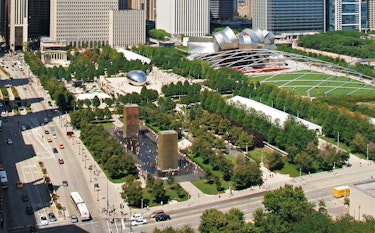
Credit: Britannica
Integration of Nature and Architecture
Modernism's approach to landscape architecture emphasized the seamless integration of nature with the built environment, creating spaces that promote a natural flow between indoor and outdoor areas.
Blurring Boundaries Between Indoor and Outdoor Spaces
One of the core ideas of modernist landscape design is to dissolve the boundaries between indoor and outdoor environments. This concept can be seen in projects like the Barcelona Pavilion by Ludwig Mies van der Rohe, where glass walls and open spaces create a fluid transition between the interior and the surrounding landscape. This approach has greatly influenced contemporary designs, inspiring the use of patios, terraces, and large windows that bring the outside in, fostering a continuous connection with nature.
Green Infrastructure
Modernist ideas also laid the foundation for the integration of green infrastructure in urban landscapes. Techniques like green roofs, vertical gardens, and living walls are modern adaptations that stem from the desire to merge natural elements with urban settings. These solutions not only enhance the visual appeal of buildings but also contribute to environmental sustainability by improving air quality, reducing heat islands, and increasing biodiversity in urban areas.
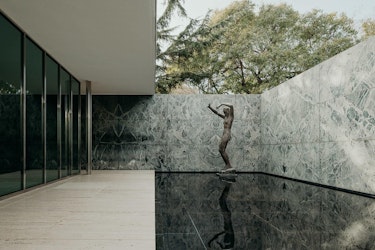
Credit: IGNANT
Minimalism and Simplicity
The principle of minimalism in modernist landscape architecture focuses on simplicity, using clean lines, geometric forms, and a restrained color palette to create spaces that are elegant and uncluttered.
Zen Garden Influence
Minimalism in landscape architecture is heavily influenced by the aesthetics of Zen gardens, where every element is purposefully placed to evoke tranquility and reflection. Modernist landscapes often incorporate similar principles, using sand, gravel, stones, and carefully selected plants to create serene environments that encourage mindfulness. This minimalist approach aligns with the modernist philosophy of removing excess to highlight the beauty of essential forms.
Geometric Planting Schemes
Another aspect of minimalism in modernist landscape design is the use of geometric planting schemes. Designers like Roberto Burle Marx used bold, abstract patterns in plant arrangements to create visually striking landscapes that doubled as living artworks. These patterns are not only pleasing to the eye but also provide a sense of order and structure, guiding movement through the space and creating a harmonious balance between nature and design.
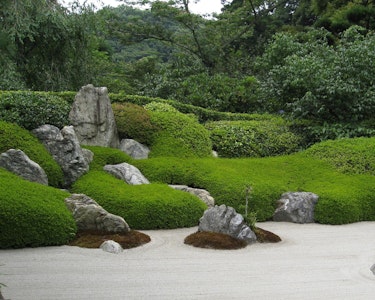
Credit: National Garden Bureau
Innovative Use of Materials
Modernism introduced the use of industrial materials like concrete, steel, and glass into landscape architecture, expanding the possibilities for design innovation.
Sculptural Elements in the Landscape
The use of concrete and other materials in sculptural forms has allowed landscape architects to create focal points that draw attention and add artistic value to outdoor spaces. Isamu Noguchi’s sculptural gardens, such as the California Scenario, are excellent examples of this technique, where the combination of natural and industrial elements results in a unique and interactive landscape. These sculptural elements often serve dual purposes, functioning as both art and practical features within the garden.
Sustainable Material Choices
Modernist landscape architecture has evolved to embrace sustainable materials, reflecting a growing awareness of environmental impact. Recycled materials, such as reclaimed wood, salvaged metal, and eco-friendly composites, are now frequently used in landscape design to reduce waste and promote sustainability. This commitment to sustainable practices is a continuation of modernism's innovative spirit, adapting traditional ideas to meet contemporary environmental challenges.
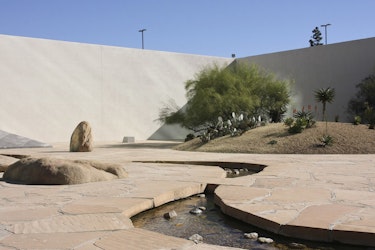
Credit: Garden Collage
As organizations continue to evolve, the focus on employee well-being will remain a key driver of workplace design. Companies that prioritize the health and happiness of their employees not only see increased productivity and creativity but also cultivate a stronger sense of loyalty and community. The modern office must be more than just a functional space—it must support physical health, mental clarity, and emotional well-being.
By focusing on biophilic design, flexibility, natural light, acoustics, social spaces, technology, and mental health, designers can create well-being-centred workspaces that foster healthier, more productive work environments. Visual storytelling communicates these essential elements, helping clients understand the transformative potential of these thoughtful design choices. The future of workspace design will continue to prioritize human experience, creating environments where employees can thrive.
